How to Make Sourdough Starter
All great sourdough bread recipes begin with a sourdough starter and this easy starter is no nonsense! Making your own sourdough starter recipe is so simple and it’s almost impossible to ruin. Keep it in the fridge to use in so many classic sourdough recipes.
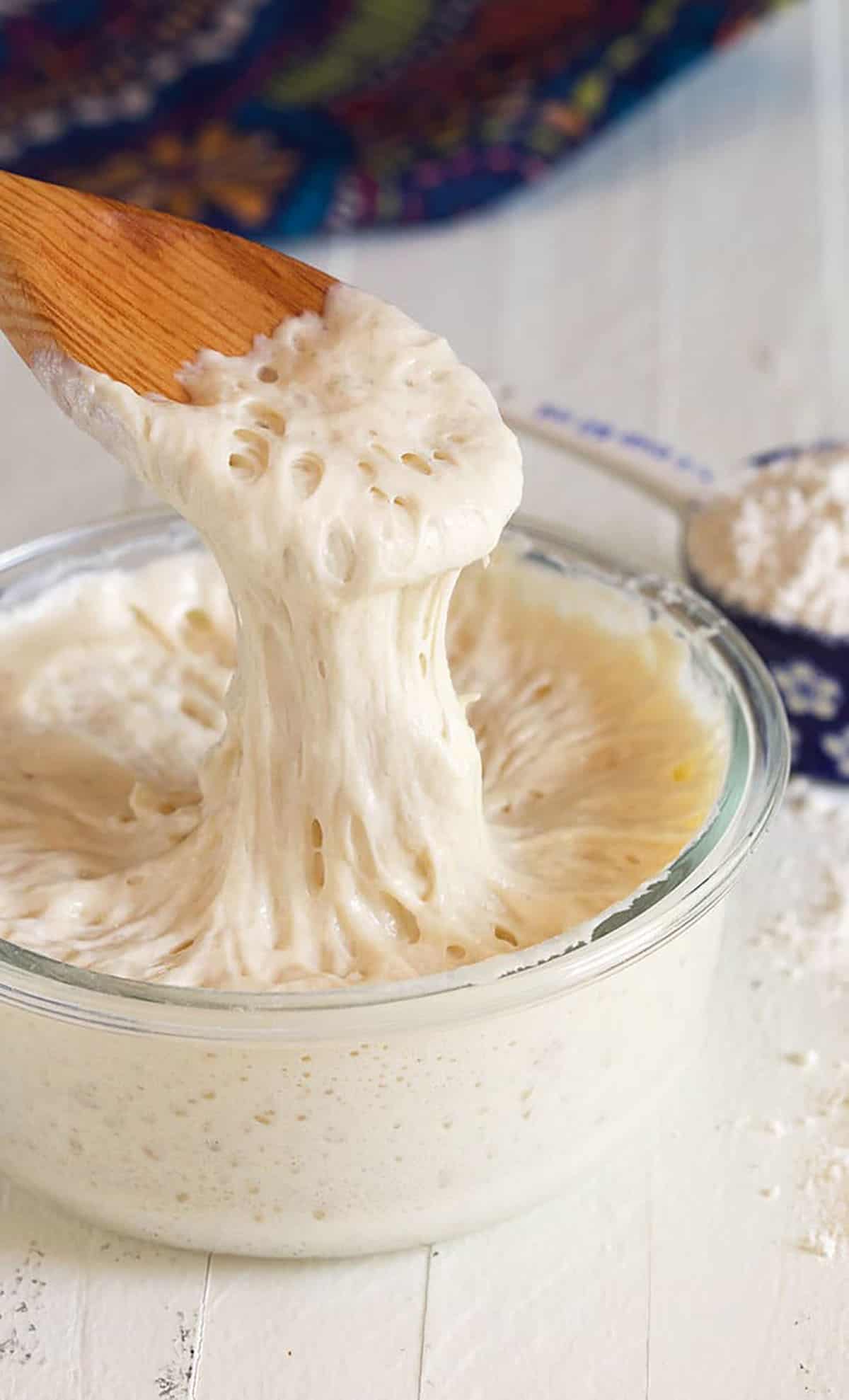
Everyone’s baking bread right now….and buying puppies. I guess the things that seem to take a ton of time and patience are finding their way into homes to keep us busy. My secret is, I’ve always loved baking bread and keep a Sourdough Starter in the fridge for bread emergencies.
My family doesn’t know that this starter is what I throw into things that need a bit of tang and a quick rise when I’m out of yeast. So, a commercial yeast shortage is never a problem because you’re, basically, making yeast at home when you make your own sourdough starter. And it couldn’t be easier to make.
Making sourdough starter from scratch isn’t fussy or complicated. It all begins with flour and water…..and a little bit of time. That’s it. Easy Peasy! Now let’s get started on your sourdough journey.
Ingredients
- Flour – The type of flour you use will affect the flavor. All purpose flour will have a more mild sour flavor and whole-grain flour will impart a more sour flavor. Rye Flour is also a popular choice for maximum sourdough flavor. We like to use a mixture of flour for our starter recipe.
- Water – Filtered water is recommended because water can contain chlorine which can kill the starter. Spring water, bottled water or filtered tap water are all great choices. Some people use pineapple juice to get the starter going faster since it lowers the pH level of the starter.
For the full measurements and instructions, see the recipe card below.
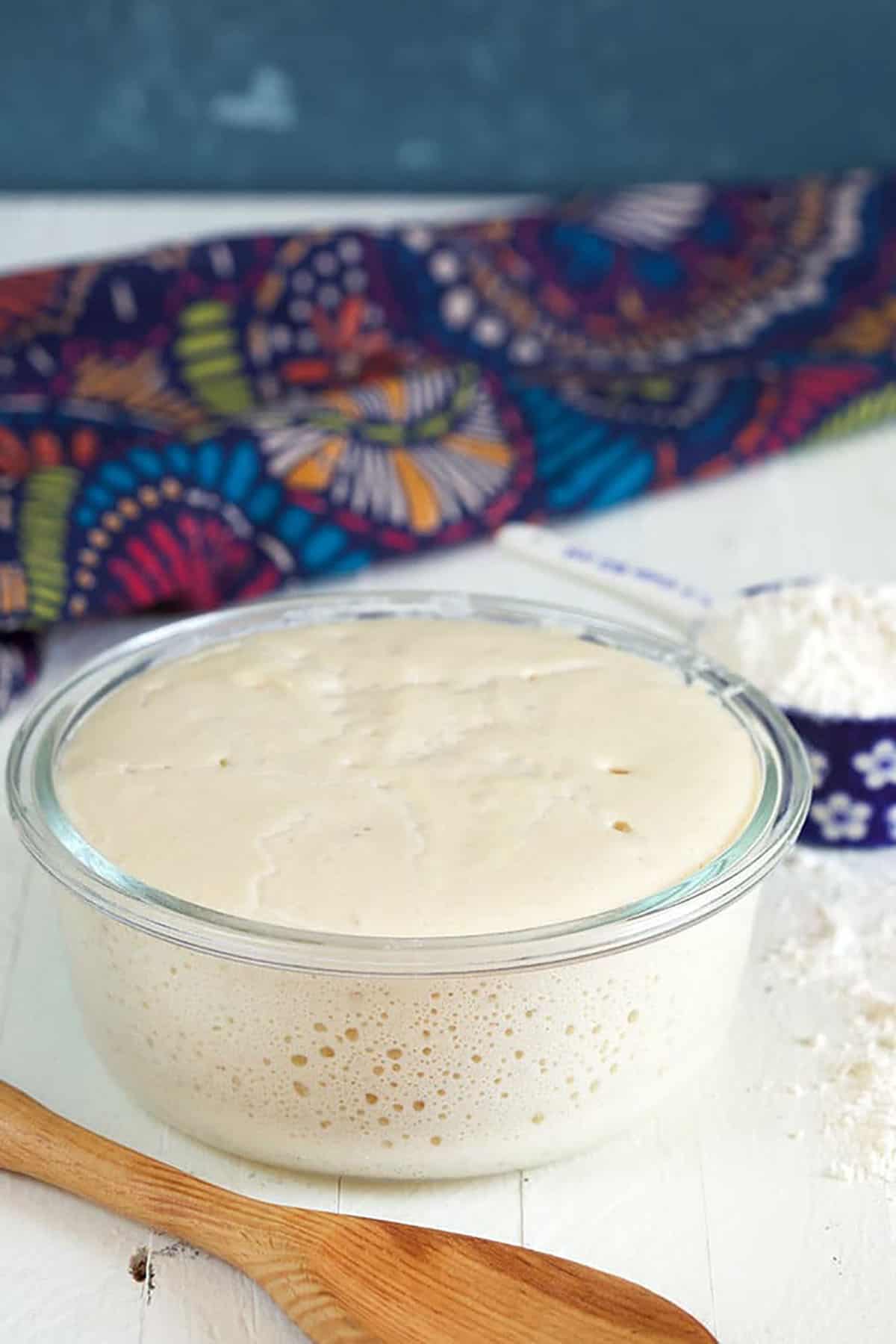
How To Make Sourdough Starter
Although I touched on this a little bit in the last paragraph, making sourdough starter from scratch is super simple to do. The type of flour you use is going to help get things moving more quickly or slowly depending on what you choose.
Wheat flours tend to move things along at a faster pace but since specialty flours are not readily available to everyone, I’ve tested this starter recipe with just about every flour you can imagine.
This Sourdough starter recipe begins with a combination of 1/4 cup all purpose flour and 1/4 cup whole wheat flour.
- Whisk the flour together in a bowl until thoroughly combined.
- In a clean jar or bowl, add 1/4 cup lukewarm water to the flour and stir until no flour is left. The dough will look thick and paste-like. Don’t worry, this is normal and it will literally transform in just one day or less.
- Cover your jar or bowl and allow to sit in a warm location, ideally over 70˚F is best, covered with a towel or plastic wrap for 24 hours. (Sometimes, I’ll keep my sourdough starter on top of my dryer while it runs to help speed things along.)
- The next day, check to see if your starter has lots of bubbles and has doubled in volume. If it looks the same, cover and allow to sit for another day.
- Once your starter doubles in volume and has a lot of bubbles forming, the fermentation process has begun and it’s time to feed.
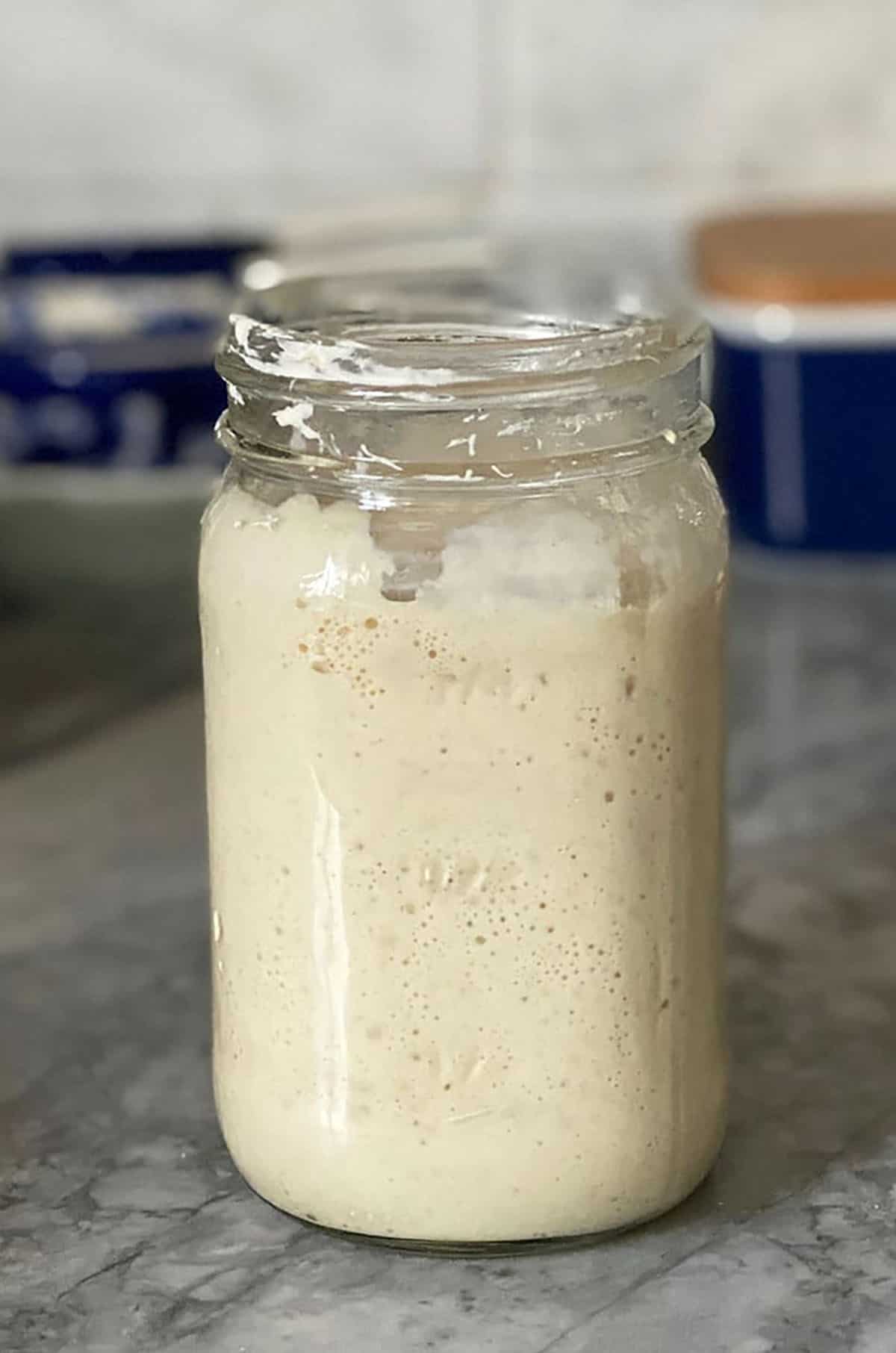
What is Sourdough Starter?
Before you could buy a commercial active dry yeast in a jar or packet at the store, there was wild yeast. Wild yeast can be found just about anywhere like in your flour or in the air. But it must be cultivated into a form that’s suitable for baking and to do that, you create a sourdough starter.
A sourdough starter is simply a combination of equal parts water and flour that’s been allowed to hang out for a few days on your kitchen counter or other warm place. After a day or so, bubbles will begin to form in the starter and that’s when you know the yeast is becoming active.
To keep things moving along, you feed your starter water and fresh flour for the next several days until the mixture becomes light, bubbly and puffy. Once it reaches that stage, it is now an active sourdough starter and it’s ready to be used in your favorite sourdough recipe.
Wild yeast is finicky when it comes to storage, it likes to be kept at cooler temperatures and in an acidic environment. It’s also is much more leisurely when it comes to rise….in that it takes much longer to proof breads.
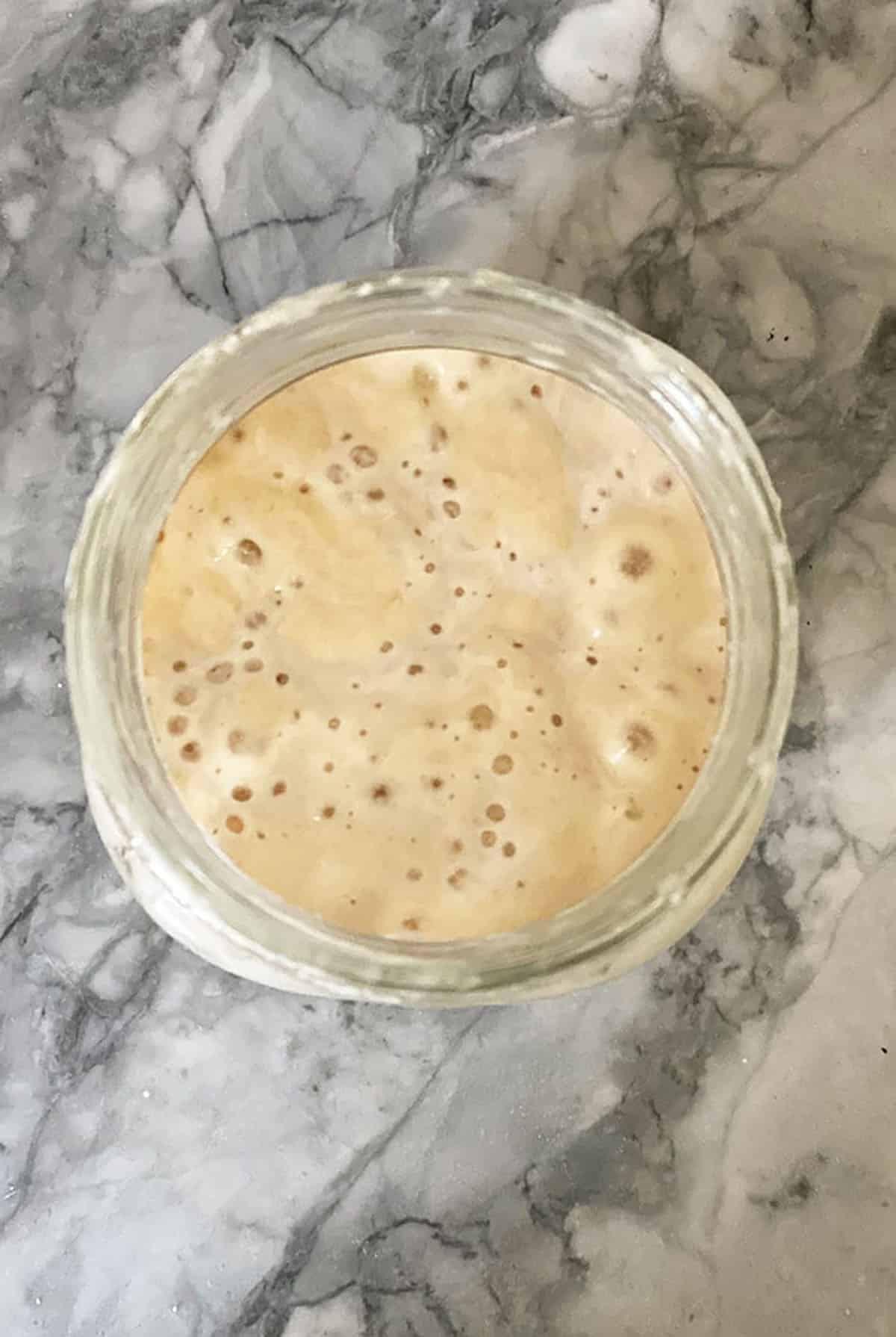
How To Feed Your Starter
Now that the starter has created some movement and developed those happy bubbles, you have to keep it happy by feeding it.
- To feed your starter, you will first remove 1/2 of the starter and discard it. Now, when I say discard it, I actually put it in another container and use it for other recipes like pancakes or waffles or muffins, crackers and biscuits. We, also, LOVE these sourdough pretzels…they’re crunchy and addicting.
- So, you’re not actually throwing it away but you do need to discard half the starter in order to move forward with feeding your starter.
- Once you’re removed half the starter, you can now feed it the remaining starter by adding 1/2 cup flour (at this point, I use all-purpose flour only) and 1/4 cup water. Stir the mixture to combine thoroughly and cover with a towel.
- Allow the starter to rest another 24 hours.
- Repeat this process of feeding your starter each day for 3-5 more days until the starter is super bubbly and billowy and light. At this point, it’s ready to use for your first loaf of bread!
This post may contain affiliate links which won’t change your price but will share some commission.
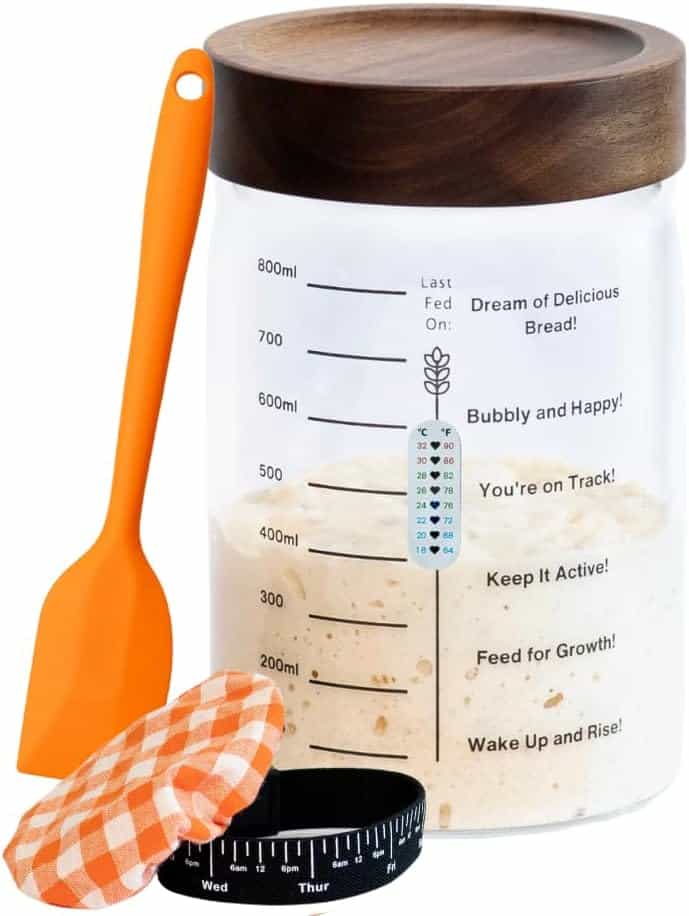
This Sourdough Starter Kit has everything you need to make and maintain your starter recipe. I love the rubber band that’s included to help keep track of your starter’s growth.
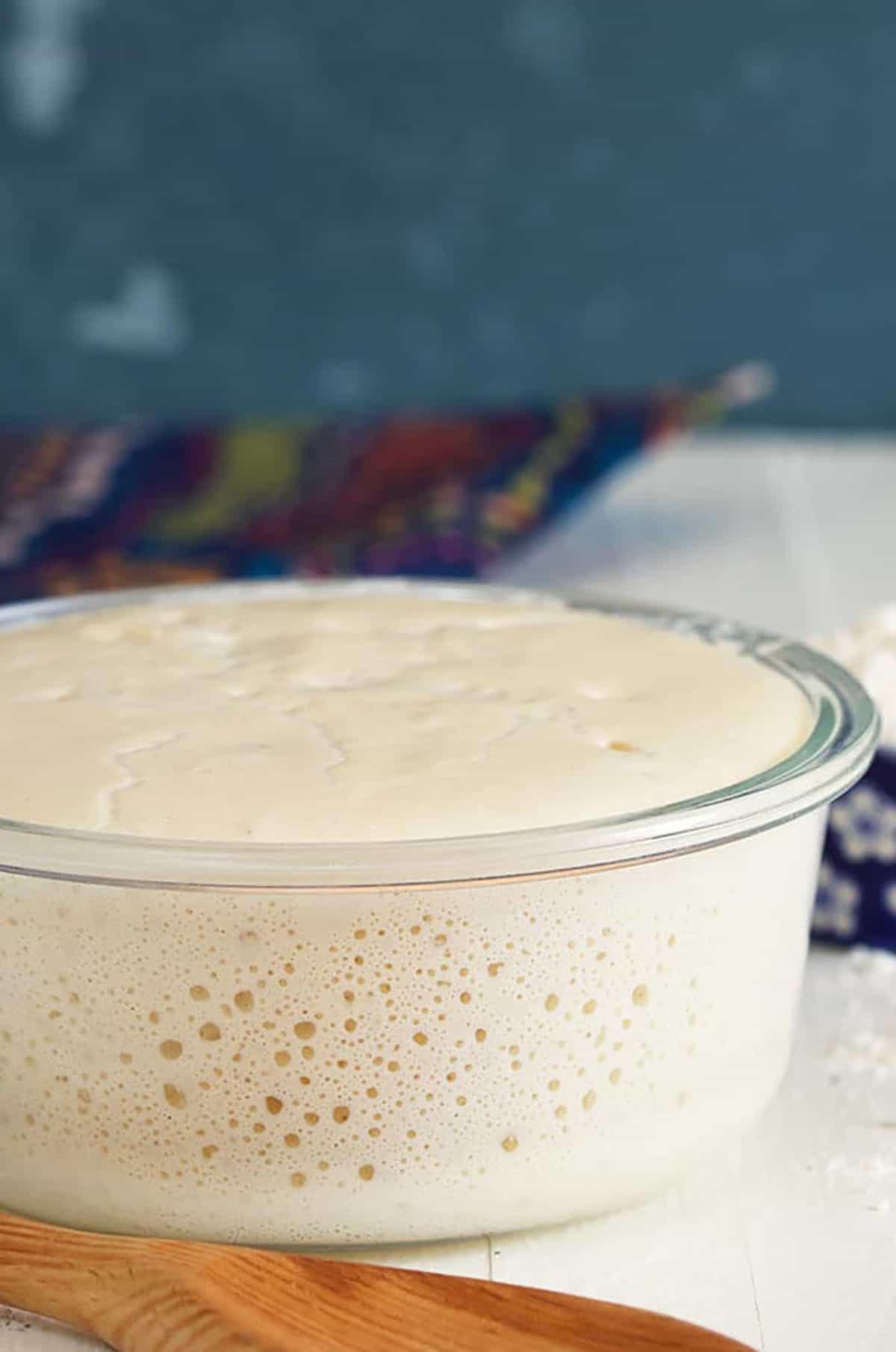
The Best Flour To Use
You can use any flour for your sourdough starter that is made from a grain. So, rice flour, wheat flour, rye flour, spelt flour, barley flour, sprouted flour and bread flour will all work well. You can make gluten free starter by using a gluten free flour like rice flour.
I haven’t tested it with most of the listed flours like rice flour so you may need to do a bit of research before going down that path.
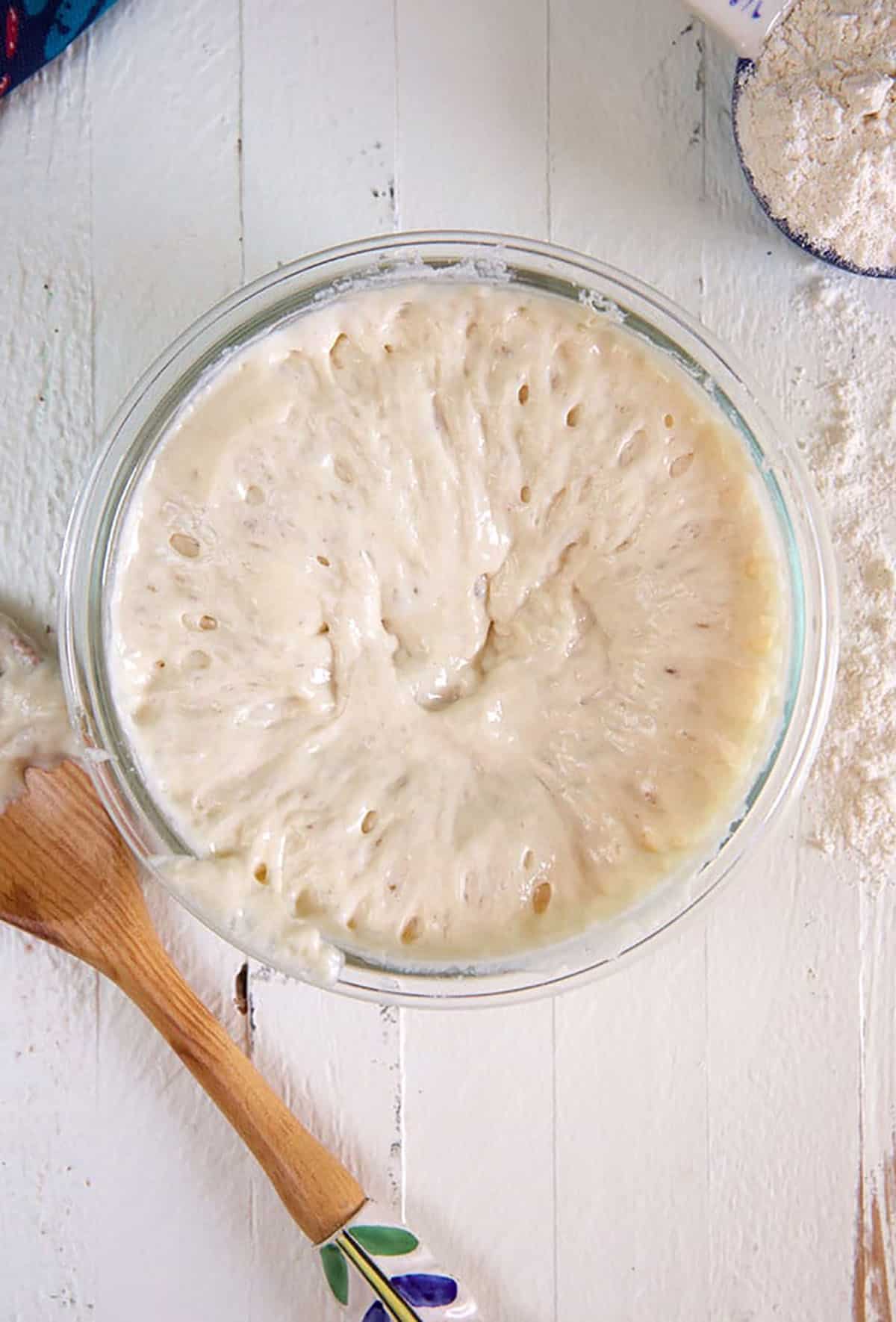
How to Store Sourdough Starter
- You can safely store your starter in the refrigerator in a container.
- Pick a feeding day and stick to it. We like to use a jar with a rubber band around it to measure the growth as it doubles.
- Remove the starter from the refrigerator and allow it to sit at room temperature for a few hours before feeding it. Feed it 1/2 cup flour and 1/4 cup water. Allow to sit overnight until bubbly then return to the refrigerator.
- You can leave your starter in the refrigerator for longer periods of time but you will need to allow it to rest at room temperature for a few days to revive it. Feed as normal and you should be back in business.
- You can successfully freeze sourdough starter by adding twice the flour at a regular feeding and then wrapping tightly in plastic wrap. Freeze for up to 3 months. Allow to thaw at room temperature and rest in a container for several days to wake it up. Then, feed as directed.
This easy sourdough starter recipe can be used in so many recipes and I love the easiest ever sourdough bread recipe. If you don’t want to wait for your starter to grow and you have traditional yeast on hand, you may want to try this easy Brioche Bread recipe or our favorite White Bread. Both have been on repeat for the past several weeks.
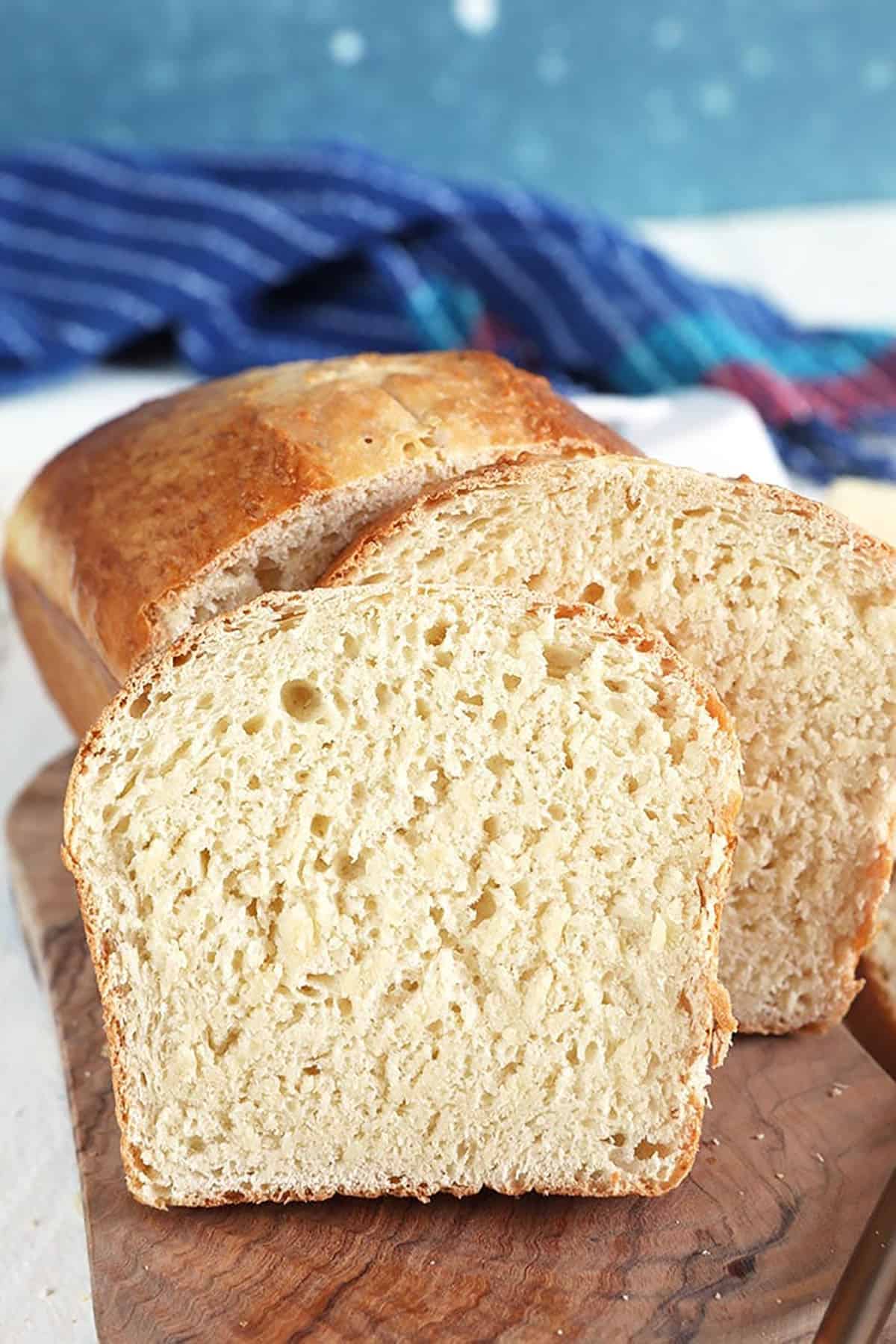
Sourdough Discard Recipes
While you feed your starter, you’ll have a bit of discard to tend with. You can toss it or you can save it in a container in the refrigerator to use in recipes. However, don’t use discard from a new starter. Be sure your sourdough starter is at least 7 days old before reserving the discard for other recipes.
You could also use this starter as a substitute for yeast in these easy Brioche Buns to give them a tangy flavor that’s so not common in a buttery brioche.
DON’T MISS A RECIPE! Be sure to follow us over on Instagram (where I shared the behind the scenes how-to on making this easy starter recipe) and on Facebook!
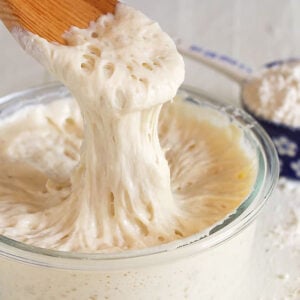
Get the Recipe: Sourdough Starter Recipe
Ingredients
- 1/4 cup Whole Wheat Flour, or other whole grain flour
- 5 lb All Purpose Flour
- 1/4 cup water, room temperature
Equipment
- 1 clean jar
Instructions
Day 1
- In a wide mouth 4 cup jar or bowl, whisk together 1/4 cup wheat flour with 1/4 cup All Purpose flour until thoroughly combined.
- Using a fork, stir in the water until no dry flour is remaining. The mixture will resemble a thick dough or paste that's a little on the dry side.
- Cover loosely with the lid or plastic wrap and leave in a warm spot in the kitchen (ideally over 70˚F) for 24-48 hours.
Day 2
- Check your starter for activity, sometimes you'll see tiny bubbles and maybe a little activity. Sometimes you won't. If you see nothing, give it a stir…cover loosely and allow it to sit for another 24 hours.
Day 3
- By this time, you should see lots of bubbles and expansion of your starter. To gauge how much your starter is growing in volume, you can place a rubber band around the jar at the top of your starter to see if it doubles in size. I prefer to just eyeball it. Discard half your starter (saving the discard in a separate container for later.)
- Add 1/2 cup all-purpose flour and 1/4 cup lukewarm water to the remaining starter. Stir to combine until no dry flour is visible. Cover loosely and allow to rest at room temperature in a warm location for 24 hours.
Day 4-7
- At this point, you should see your starter doubling in volume with lots of bubbles each day. Continue feeding your starter each day by discarding half the starter then feeding with 1/2 cup flour and 1/4 cup water.
- Cover loosely and allow to rest at room temperature in a warm location for 24 hours. By day 7, your starter should be ready to use in your favorite recipe.
- To test if your starter is ready to use, feed the starter and time how long it takes to double in size. When your starter doubles in less than 4 hours, it's ready. Alternatively, you can do the float test. Simply fill a glass with water and place a bit of starter in the water. If it floats, it's ready to use. (I'm not a fan of the float test….just saying.)

121 Comments on “How to Make Sourdough Starter”
This looks really good please send me the website thank you
Its on day two and mine hasn’t doubled in size and no bubbles it has some wet areas. But still looks like it did when I started it. Used whole wheat flour, white flour, and well water.
Hi Stacy, Sometimes your starter may be a little lazy. To help wake it up, you can do a few things….put it in a much warmer location such as next to a heating vent (unless you’re running the air conditioning), on top of a dryer that you just ran or in a slightly sunny spot. Sometimes I’ll put mine in the oven (on a baking sheet in case it wakes up very quickly) on the proof setting or that I had on the warm setting for a little but be sure to turn it off. The residual heat should help things get moving. I have had starter that’s taken up to 4 days to get itself going and I also have well water so that shouldn’t be an issue at all.
Ok thank u I will try my proof setting on oven. I have been putting it in the sun when it’s out. But it’s been really cloudy and cool temps here.
As someone who has made their own starter, more than once, I’d like to offer some tips. If your house is coolish in winter, put the container of starter on a pan (to catch any overflow), in your oven with the light on. Sometimes overnight in the oven with the light on is too warm, so I have turned it off and left it in there. Make sure you don’t preheat the oven with the starter still in it.
I also found that stirring the starter a couple of times during the day at the very beginning, helped get things moving.
I have never used my starter before day 15 to make bread. As well waited till day 7 to start collecting the discard in a jar.
Making your own starter from just water & flour is so satisfying and the resulting bread you bake with it is even more satisfying.
Thank you so much for your helpful tips! I’m sure others will appreciate them, as well.
What kind of container do I use to keep it in the fridge? I’m a beginner this will be my first time
For the discard, I just use a jar with a tight fitting lid or a storage container.
Hi there! thanks for the recipe! I am hoping this is the starter that will finally work for me! Just a question about day two – I have not gotten there yet, but what if there is a lot of activity, do you discard half and feed? Leave it for the next day? feed it without discarding?
Thank you!
Yes, if it takes off a bit faster than you’re ready for just do the discard a little earlier. If my house is warm, sometimes I have to discard more frequently but during the winter it’s usually slow. If your discard is slow moving then just wait an extra day, discard per instructions and it should start going. It helps to put it somewhere warm like on top of the counter above a dishwasher if it’s running or on your dryer while it’s running. (We did this a lot before we had an upstairs laundry room.)
Help! My starter is ready to go but I don’t know what to do at this point. Someone else asked this question but were led back to how to start a sourdough starter. Is there a recipe for preparing the starter to be baked?
Yes, there are several recipes on here….this is a great starter bread and in the body of the article I included links to other recipes for the discard. https://thesuburbansoapbox.com/easy-no-knead-sourdough-bread-recipe/
I can’t wait to start mine! Thank you for sharing! Quick question… with the 1st discard (1/2), can that not be placed in another jar and continue with the same directions that were given for what was kept in the original container? So you’d end up with 2 starters, split from the original. If that makes any sense!? Thank you!
Yes, that’s correct….you can keep the discard and start a second starter to have two going at once. But, be careful because you may end up with a bunch of starters taking over your kitchen at some point. 🙂
Can you make it is a storage or freezer bag?
You can but double bag in case of leaks. And I would prop it up in a bowl or a glass.
The discarding process is confusing to me. So, once you are feeding weekly… do you discard every time? What if you’re taking out starter to bake bread in between feedings? What is the minimum amount of starter you should always keep to feed?
I discard every time I feed it but I don’t discard any when taking starter to bake bread. That’s your “discard”.
So do I have to discard half of the starter like ever? Could I take the discarded starter and make a new batch? The discarding part has always confused me. Thanks
Yes, so a discard is meant to be discarded but I save mine in the refrigerator for recipes that call for sourdough discard like my Everything Crackers. You can also use it for a new batch or to give it away to a friend.
I see that there is no listing for yeast in the ingredients. Do you not use yeast in this recipe?
Nope! No yeast needed as the flour will start it’s own fermentation which is all the yeast you need.
I think I need help too. I’m on day 7 and it has not been bubbly over the past few days and I don’t think it’s totally doubled either. I put it in a warm location- usually keep it by the stove when I cook and then leave it on there to sit as it’s normally warm by the stove. I wonder if I need to start over 🙁
So is my only indicator of its ready is if it doubles in size within 4 hours?
Sometimes mine takes a full day to double in size and I have just move forward with feeding it again when it seems to be lazy. It really needs to be cozy and warm with no draft as the started can be finicky when the weather starts to get cooler. Also, humidity can play a factor, as well.
Can I use only whole wheat flour instead of half whole wheat and half white flour?
Yes! You can definitely use all whole wheat flour.
Can i just use flour…..and a maybe dumb question…how about self-rising flour? (Can you tell i’ve never been much of a cook?….but can follow instructions!
Hi! No dumb questions here. You can use regular all purpose flour but not self rising flour. That could be a disaster. Plus, it’s more expensive. Self Rising flour already has baking powder and some salt added and is usually made with a softer, lower protein all purpose flour. You definitely need the higher protein flour.
I was wondering what is done with the discarded starter to be used later I think you said. I’m not one to throw things out if they have a purpose.
Thank you
Hi Karen! I store it in a container in the refrigerator and use it for pretzels, crackers or pancakes. At times, I do have to throw some away because it can kind of take over.
Hi! So I’m on like day 6. Not doubling. Not really moving much or at all for that matter. I have it in a consistently warm spot. I do feedings same time everyday. Would you have any suggestions for me as to what I’m doing wrong. I’m currently using king Arthur’s bread flour. Warm filtered water. I just don’t know where I’m going wrong.
Hi Marissa! sometimes Sourdough starter can be fickle….if you’re on day 6 something may have gone wrong or contaminated the flour. Unfortunately, I would start over if I ran into that issue. I’m so sorry, it’s definitely a labor of love.
I have what may sound like a dumb question, I’ve seen other starter’s but they’ve called for instant potato’s and I also noticed that your recipe didn’t use any yeast and I thought that was what fed it or what was usually in a lot of sourdough breads.
No need for instant potatoes. The yeast feeds off the new flour that’s being added.
Hi, Kellie! I’m on day 2 of making my sourdough starter. I feed it at night time. Yesterday when I woke up it had doubled in size (maybe even a bit more). Over the course of the day it gradually went down. Last night I did a discard, fed it, but when I woke up this morning it has not grown at all. (Still has some bubbles.) Is this normal? Do I just keep feeding it once every 24 hours and hopefully it will grow again like it did? Or do I need to maybe feed it more often?
Hi! Your comment was in my spam but I’m going to respond just in can you want to give it another go. So, the starter is not dead but you may need to put it in a warmer location. Sometimes when my starter stalls out I’ll put it in the laundry room or on top of the dishwasher (on the counter but it still gets warmer above the dishwasher) to warm it up. When it’s a little chilly, the starter will take much longer to move along. Don’t do a discard/feed until it’s doubled in size.